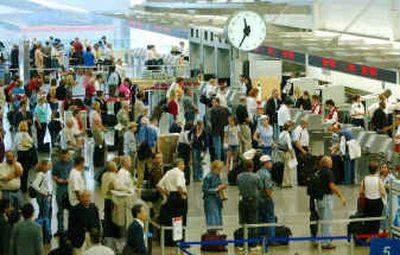Passengers getting their fill

WASHINGTON — This summer is shaping up as the worst for flight delays since 2000, when nearly one in every four planes was late.
The gloomy picture is due to the large number of people traveling — passenger loads have returned to pre-Sept. 11, 2001, levels — and a weather pattern producing severe storms in some of the nation’s most congested airspace.
On Wednesday, storms delayed flights to New Jersey’s Newark Liberty International Airport by more than three hours. Other airports along the East Coast — in Baltimore, Washington, Boston, New York and Philadelphia — experienced delays up to an hour.
During the summer of 2000, severe thunderstorms coupled with large passenger loads and work slowdowns led to massive delays. While few experts expect this year’s problems to be as pronounced, most agree there will be significantly more delays than the previous three summers.
“Airplanes are going to be very full, airports are going to be crowded, there are going to be long lines at security,” said David Swierenga, an airline economist and president of Vienna, Va.-based AeroEcon.
Passengers know it already.
“The planes are really jammed and service seems to be suffering,” said Ken Cahill, a traveler from Asheville, N.C., passing through Reagan Washington National Airport.
Another traveler at the airport, Don Greenberg of Cincinnati, said he’d seen problems from the increase in passengers and from lines at security checkpoints. “I travel every other week and sometimes three to four cities are delayed,” he said.
Swierenga believes 2004 will top the record 666 million airline passengers in 2000. A rebounding economy and the lowest fares in a decade have lured people back to the skies.
Through May, the percentage of late-arriving flights was up 27 percent over the first five months of 2003, reversing steady improvements in on-time performance since 2000. The Transportation Department reported about one in five flights arrived 15 minutes or more behind schedule, the threshold for a flight to be considered delayed. About one-quarter of all late flights were more than an hour behind schedule.
Bad weather is the single biggest cause of delays. Unusual weather patterns have caused a high number of severe thunderstorms in some of the country’s most congested areas — from Chicago east through the upper Midwest, the Northeast and Mid-Atlantic. Bad weather at a major airport has a cascading effect, causing delays throughout the aviation system.
“This has been a level of thunderstorm activity that we haven’t experienced for a few years,” said Federal Aviation Administration spokesman Greg Martin.
Worsening the problem is the larger number of planes in the air. As airlines have sought to meet the increasing demand for direct flights, they have replaced larger planes with smaller, more efficient jets. The result is that it takes more planes to carry the same number of people, creating a further burden for the air traffic system.
The FAA has taken steps to minimize delays. New computer programs let pilots fly more direct routes and enable controllers to track the paths of thunderstorms so planes can be rerouted rather than delay takeoffs until a storm has passed.
Air traffic controllers also are holding some planes on the ground longer if they’re headed toward crowded airports. That way, backed-up planes can get into the air more quickly when the weather clears because the space over the airport will be less crowded.
Martin said the change disperses small delays throughout the aviation system instead of creating substantial delays at one airport.
The FAA earlier this year negotiated with two of the biggest airlines — United and American — to reduce their schedules at Chicago’s O’Hare International Airport by 7.5 percent between noon and 8 p.m. Delays at O’Hare can cause backups throughout the system because so many flights connect through it.
Air Travelers Association President David Stempler advises calling the airline before leaving for the airport. “Check on your specific flight, because even though the airport itself may be on delay, it may not affect your particular flight,” he said.